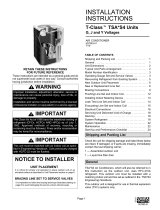
Page 7
TSA*H4 SERIES
PLACING UNIT ON SLAB
When installing unit at grade level, the top of the slab
should be high enough above grade so that water from
higher ground will not collect around the unit. The slab
should have a slope tolerance as described in figure 5,
detail B.
ROOF MOUNTING
Install the unit a minimum of 6 inches (152 mm) above the
roof surface to avoid ice build-up around the unit. Locate
the unit above a load bearing wall or area of the roof that
can adequately support the unit. Consult local codes for
rooftop applications.
If unit coil cannot be mounted away from prevailing winter
winds, a wind barrier should be constructed. Size barrier at
least the same height and width as outdoor unit. Mount
barrier 24 inches (610 mm) from the sides of the unit in the
direction of prevailing winds.
NOTICE
Roof Damage!
This system contains both refrigerant and oil. Some
rubber roofing material may absorb oil and cause the
rubber to swell when it comes into contact with oil. The
rubber will then bubble and could cause leaks. Protect
the roof surface to avoid exposure to refrigerant and oil
during service and installation. Failure to follow this
notice could result in damage to roof surface.
New or Replacement Line Set
This section provides information on new installation or
replacement of existing line set. If a new or replacement
line set is not required, then proceed to Brazing
Connections on page 9.
Field refrigerant piping consists of liquid and suction lines
from the outdoor unit (braze connections) to the indoor unit
coil (flare or braze connections). Use Lennox L15 (braze,
non-flare) series line set, or use field-fabricated refrigerant
lines as listed in table 2.
NOTE - When installing refrigerant lines longer than 50
feet, see the Lennox Refrigerant Piping Design and
Fabrication Guidelines, CORP. 9351-L9, or contact
Lennox Technical Support Product Applications for
assistance.
To obtain the correct information from Lennox, be sure to
communicate the following points:
Model (TSA*H4) and size of unit (e.g. -060).
Line set diameters for the unit being installed as listed
in table 2 and total length of installation.
Number of elbows and if there is a rise or drop of the
piping.
If refrigerant lines are routed through a wall, seal and
isolate the opening so vibration is not transmitted to the
building. Pay close attention to line set isolation during
installation of any HVAC system. When properly isolated
from building structures (walls, ceilings. floors), the
refrigerant lines will not create unnecessary vibration and
subsequent sounds.
IMPORTANT
Mineral oils are not compatible with HFC-410A. If oil
must be added, it must be a Polyol ester oil.
The compressor is charged with sufficient Polyol ester oil
for line set lengths up to 50 feet. Recommend adding oil to
system based on the amount of refrigerant charge in the
system. No need to add oil in system with 20 pounds of
refrigerant or less. For systems over 20 pounds - add one
ounce of every five pounds of refrigerant.
Recommended topping-off POE oils are Mobil EAL
ARCTIC 22 CC or ICI EMKARATE RL32CF.
MATCHING WITH NEW OR EXISTING INDOOR COIL
AND LINE SET
The RFC1-metering line consisted of a small bore copper
line that ran from condenser to evaporator coil. Refrigerant
was metered into the evaporator by utilizing
temperature/pressure evaporation effects on refrigerant in
the small RFC line. The length and bore of the RFC line
corresponded to the size of cooling unit.
If the TSA*H4 is being used with either a new or existing
indoor coil which is equipped with a liquid line which served
as a metering device (RFCI), the liquid line must be
replaced prior to the installation of the TSA*H4 unit.
Typically a liquid line used to meter flow is 1/4" in diameter
and copper.
LIQUID LINE FILTER DRIER INSTALLATION
The filter drier (one is shipped with each TSA*H4 unit)
must be field installed in the liquid line between the outdoor
unit's liquid line service valve and the indoor coil's metering
device (fixed orifice or TXV) as illustrated in figure 6. This
filter drier must be installed to ensure a clean,
moisture-free system. Failure to install the filter drier will
void the warranty. A replacement filter drier is available
from Lennox. See Brazing Connections page 9 for
special procedures on brazing filter drier connections to
the liquid line.
OUTDOOR
UNIT
LIQUID LINE
SERVICE
VALVE
LIQUID LINE
FILTER DRIER
LINE
LIQUID
LINE
BRAZE CONNECTION POINTS
Figure 6. Typical Liquid Line Filter Drier In
stallation




















